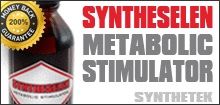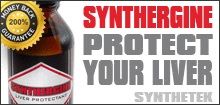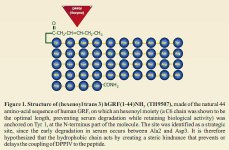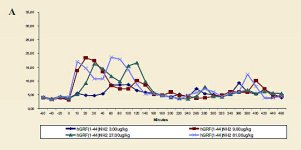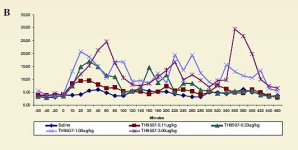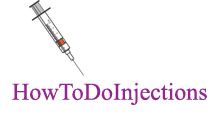- Joined
- Jul 25, 2008
- Messages
- 1,700
gyno; said:Site reduction of adipose. Most say it is impossible (barring of course hormonal manipulation which may cause fat storage in particular areas). My question is two fold
1. Have you found any drug/supplement/procedure that would lead you to believe this may not be ture? I've noted from a recent post that you like to do things people say are impossible, so I wonder if you have experimented with this. If so, what were your results
2. I have a very strange thing going on in my body. I store fat first in my breast/chest area. I lose it last from there as well. Even when I KNOW that progesterone/estrogen is in check, I accumulate fat in that area first. Not only that, but in copious amounts. It's rather disturbing. I've even gone so far as to having it liposuctioned, and although it took much longer, upon gaining back some fat (going from a true 7% to around 11%) it returned to my chest first like it was a priority..
This could be a big topic to explore and discuss. The answer is yes I have been interested in the possibility of using MT-II for spot reduction. It is demonstrated in mice and I put out a "feeler" here on this board on the topic of MT-II & weightloss. (weightloss unrelated to appetite decrease).
I didn't specifically post on spot reduction. Here is that thread: MTII - weightloss
I get interested in so many things that I can't keep track. Here were my thoughts at the time and perhaps it is directly relevant to you.
Brown Adipose Tissue -
From Wikipedia:
...more recently it has become clear that brown fat is not closely related to white fat, but to skeletal muscle, instead. Further, recent studies[3] using Positron Emission Tomography scanning of adult humans have shown that it is still present in adults in the upper chest and neck. The remaining deposits become more visible (increasing tracer uptake) with cold exposure, and less visible if an adrenergic beta blocker is given before the scan. The recent study could lead to a new method of weight loss, since brown fat takes calories from normal fat and burns it. Scientists were able to stimulate brown fat growth in mice, but human trials have not yet begun.
Here is a little background science from Effects Of The Melanocortin Agonist Melanotan Ii, Central Pro-Opiomelanocortin And Interleukin-6 Gene Therapies On The Regulation Of Body Weight And Energy Homeostasis, Gang Li, A Dissertation Presented To The Graduate School Of The University Of Florida In Partial Fulfillment Of The Requirements For The Degree Of Doctor Of Philosophy University Of Florida 2003
Brown Adipose Tissue and Energy Expenditure
BAT is a specialized fat tissue in mammals heavily innervated by sympathetic nerves. The brown adipocytes contain abundant mitochondria with closely packed cristae that confer the characteristic brown color to this tissue. Thermogenesis in BAT is mainly mediated by norepinephrine activation of sympathetically innervated ß3 adrenoreceptors (Nedergaard et al., 2001). Energy expenditure through brown adipose tissue thermogenesis contributes either to maintenance of body temperature in a cold environment or to consumption of food energy, i.e. cold-induced or diet-induced thermogenesis. Both mechanisms involve a specific and unique protein: the uncoupling protein-1 (UCP1). UCP1, a 32-kDa protein, is exclusively expressed in mitochondria of brown adipocytes where it uncouples respiration from ATP synthesis and dissipates the proton gradient as heat (Nedergaard et al., 2001).
Skeletal Muscle and Energy Expenditure
Over much of the past century, the skeletal muscle, by virtue of its large size contributing 30–40% of body mass, has been considered the major tissue that enables mammals to adapt to changes in food availability. For example, the rate of heat production during periods of food scarcity is turned down in the skeletal muscle to conserve energy while it is geared up during food abundance to burn excess energy. However, the mechanisms by which skeletal muscle could allow such adaptations remain elusive. UCP3, a UCP1 homologue in muscle, has been proposed to participate in the regulation of thermogenesis and lipid metabolism (Wang et al., 2003). However, several recent studies cast doubt on its physiological relevance to muscle mitochondrial uncoupling (Hesselink et al., 2003; Cadenas et al., 1999; Iossa et al., 2001). Leptin has also been indicated to have direct thermogenic effects in skeletal muscle. Presumably, these effects require both the long form of leptin receptors and PI3K signaling (Dulloo et al., 2002). Muscle-type Carnitine palmitoyltransferase I (M-CPT I) is an important enzyme for energy homeostasis and fat metabolism by modulation of long-chain fatty acid (LCFA) entry into mitochondria, where the LCFAs undergo beta-oxidation (Jeukendrup, 2002). M-CPT I is located in the outer mitochondrial membrane and sensitive to inhibition by malonyl-CoA, which makes it an important site for metabolic regulation. Malony-CoA is the product of a reaction catalyzed by Acetyl-CoA carboxylase (ACC), the first step in fatty acid biogenesis from acetyl-CoA and preserved in nonlipogenic tissues such as skeletal muscles and heart muscle (Jeukendrup, 2002). The formation of malonyl-CoA may therefore offer a main control point of fatty acid catabolism through inhibition of CPT I in muscle.
BAT is a specialized fat tissue in mammals heavily innervated by sympathetic nerves. The brown adipocytes contain abundant mitochondria with closely packed cristae that confer the characteristic brown color to this tissue. Thermogenesis in BAT is mainly mediated by norepinephrine activation of sympathetically innervated ß3 adrenoreceptors (Nedergaard et al., 2001). Energy expenditure through brown adipose tissue thermogenesis contributes either to maintenance of body temperature in a cold environment or to consumption of food energy, i.e. cold-induced or diet-induced thermogenesis. Both mechanisms involve a specific and unique protein: the uncoupling protein-1 (UCP1). UCP1, a 32-kDa protein, is exclusively expressed in mitochondria of brown adipocytes where it uncouples respiration from ATP synthesis and dissipates the proton gradient as heat (Nedergaard et al., 2001).
Skeletal Muscle and Energy Expenditure
Over much of the past century, the skeletal muscle, by virtue of its large size contributing 30–40% of body mass, has been considered the major tissue that enables mammals to adapt to changes in food availability. For example, the rate of heat production during periods of food scarcity is turned down in the skeletal muscle to conserve energy while it is geared up during food abundance to burn excess energy. However, the mechanisms by which skeletal muscle could allow such adaptations remain elusive. UCP3, a UCP1 homologue in muscle, has been proposed to participate in the regulation of thermogenesis and lipid metabolism (Wang et al., 2003). However, several recent studies cast doubt on its physiological relevance to muscle mitochondrial uncoupling (Hesselink et al., 2003; Cadenas et al., 1999; Iossa et al., 2001). Leptin has also been indicated to have direct thermogenic effects in skeletal muscle. Presumably, these effects require both the long form of leptin receptors and PI3K signaling (Dulloo et al., 2002). Muscle-type Carnitine palmitoyltransferase I (M-CPT I) is an important enzyme for energy homeostasis and fat metabolism by modulation of long-chain fatty acid (LCFA) entry into mitochondria, where the LCFAs undergo beta-oxidation (Jeukendrup, 2002). M-CPT I is located in the outer mitochondrial membrane and sensitive to inhibition by malonyl-CoA, which makes it an important site for metabolic regulation. Malony-CoA is the product of a reaction catalyzed by Acetyl-CoA carboxylase (ACC), the first step in fatty acid biogenesis from acetyl-CoA and preserved in nonlipogenic tissues such as skeletal muscles and heart muscle (Jeukendrup, 2002). The formation of malonyl-CoA may therefore offer a main control point of fatty acid catabolism through inhibition of CPT I in muscle.
So is it Brown Fat that is a problem for you? I kinda doubt it. I believe the more brown fat you have in the chest area the easier it will be to lose fat there. When you diet down perhaps you are reducing brown fat and making it more difficult to reduce white fat. Perhaps tissue specific resistance to leptin is to blame for white fat accumulation... the tissue may have other signaling defects
Here is how administering MT-II worked in one study:
In lean rats, MTII prevented the decrease in brown adipose tissue UCP1, UCP2, and UCP3 expression and muscle UCP3 occurring during food restriction. In obese animals, MTII markedly increased brown adipose tissue (7-fold) and muscle (2.5-fold) UCP3 expression. The decrease in liver carnitine palmitoyltransferase-1 elicited by food restriction in lean and obese rats was prevented by MTII administration. In summary, the effects of MTII resemble those of leptin and are more marked in obese than in lean animals, in keeping with their reported reduced endogenous melanocortin tone. Melanocortin agonists may be useful in the treatment of obesity associated with impaired leptin signaling. - The Leptin-Like Effects Of 3-D Peripheral Administration Of A Melanocortin Agonist Are More Marked In Genetically Obese Zucker (Fa/Fa) Than In Lean Rats, Philippe Cettour-Rose And Franc¸ Oise Rohner-Jeanrenaud, Endocrinology 143: 2277–2283, 2002
Lots of things going on and I don't have a clear idea, just that MT-II may be effective at spot reduction in some spots for some people w/ certain specific characteristics/defects in signaling.
















